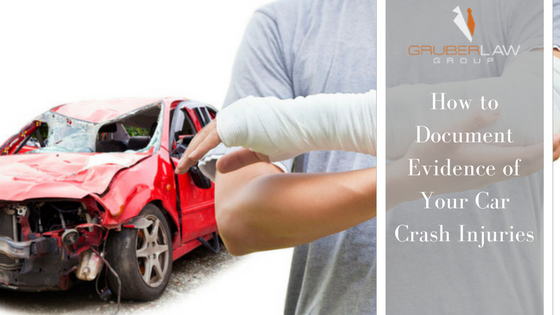 For this reason, knowing how to document your injuries properly is paramount for increasing your odds of obtaining a fair settlement. In fact, in most cases the amount the defendant is willing to settle for increases in proportion to the strength of the presented evidence.
For this reason, knowing how to document your injuries properly is paramount for increasing your odds of obtaining a fair settlement. In fact, in most cases the amount the defendant is willing to settle for increases in proportion to the strength of the presented evidence.
Promote your case’s chance of success, and ensure that the nature of your injuries can be clearly understood by capturing the following types of evidence and organizing them with the help of a San Francisco car accident attorney.
Capture Photos of Your Injuries and the Scene Immediately After the Crash
Some of the best pieces of evidence come from photos taken of the crash scene as close to the incident as possible. If you are seriously injured, you will not be able to run around and take these photos — nor should you. Try to stabilize your injuries, and accept any emergency medical treatment, including an ambulance evacuation, if you feel it may help improve your outcome.
However, you can still capture some photos while waiting for treatment, especially if you have someone willing to walk around and snap them for you. Take pictures of your vehicle to set the scene for how your injuries occurred. For instance, a defendant may contest that an injury to the side of the victim was unlikely given the crash was a rear-end collision, but photo evidence of a door panel jutting into the driver’s seat puts this idea to rest.
Capture pictures of the vehicle interior and exterior from multiple angles as well as pictures of the accident scene as a whole. Someone should be able to piece together the entire space from these photos.
Most importantly, take pictures of your injuries when they are fresh, and follow-up with photos to document swelling or bleeding every few hours after the incident. Additionally, record the contact information of any eyewitnesses to the accident so that you can reach out to them for statements in the future.
Get a Thorough Examination From Your Doctor With Detailed Notes
To document a car accident injury properly, you may have to go beyond your typical medical exam. Ask to have any images or tests that may be needed to grasp the full extent of the injury. Have your doctor describe, in detail, the nature of your injury and any peripheral conditions likely to result. For instance, if you have a broken bone, they can describe the prognosis of how swelling in the region may affect other limbs or organs. Include as much specific information about each region of the injury, such as if bruising is worse on the right or the left side.
Accompany these notes with your own input. Have them describe how your range of mobility is limited and any pain you may feel. Many doctors will leave most of your subjective experience out of clinical documentation, but having an official record of your pain immediately after the accident is paramount.
During the healing process and follow-up visits, add to this documentation as your condition changes over time. You want to show that your injury was not only severe but that the healing process occurred slowly.
Save All Your Receipts
Every single cost related to your injury should be documented through invoices and receipts. If you would not have to pay for something had the injury not occurred, such as a deck pass during a follow-up clinic visit, it could be eligible for inclusion within your requested damages.
If you have a medical or auto insurance policy that would normally cover the injuries if another party was not potentially at-fault, have your insurance company share any documentation they have created.
Record Your Own Words, Thoughts, and Feelings
First-hand testimony of your injury is important for connecting physical documentation to your personal experience. Type out or voice record your own narrative of how the accident occurred and how you knew you were injured. Statements like “I could feel my bone making contact with the seat leather” provide important details and help corroborate the physical evidence presented.
Record your perspective of events and a narrative of the accident as soon as possible. You can have witnesses add to this narrative to provide additional context. Fellow passengers can be especially informative, but someone on the street seeing you hobble out of the car can also confirm your own words.
Organize Your Evidence With the Help of a San Francisco Car Accident Attorney
Collecting tons of compelling evidence is not enough to strengthen a car accident injury case without legal expertise guiding your strategy. You must have an experienced car accident injury lawyer in San Francisco to assemble the evidence into a single, structured argument and narrative, with each small detail backing up the big picture.
Stacks and stacks of evidence rarely tell a story on their own, after all. They must be explained to the judge, jury, and opposition clearly so that everyone understands your injuries — and how they happened — almost as well as you do.
Start forming your case, and get personalized advice on how to best collect your needed evidence, when you contact a car accident lawyer today for a free consultation.









Leave a Reply